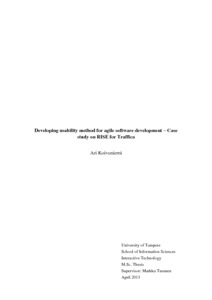Developing usability method for agile software development - Case study on RISE for Traffica
KOIVUNIEMI, ARI (2013)
KOIVUNIEMI, ARI
2013
Vuorovaikutteinen teknologia - Interactive Technology
Informaatiotieteiden yksikkö - School of Information Sciences
This publication is copyrighted. You may download, display and print it for Your own personal use. Commercial use is prohibited.
Hyväksymispäivämäärä
2013-04-30
Julkaisun pysyvä osoite on
https://urn.fi/urn:nbn:fi:uta-1-23561
https://urn.fi/urn:nbn:fi:uta-1-23561
Tiivistelmä
This study presents the development work done for RISE for Traffica, a tool for managing network element adaptations that are used by Nokia Siemens Networks’ real-time network monitoring system Traffica. The goal of this study was to develop the new tool and come up with an inexpensive and fast usability method that would verify the product’s usability and provide feedback for its further development.
RISE for Traffica is an expansion to existing data management system RISE allowing it to be used with Traffica. RISE for Traffica is being developed to replace several currently used tools and change the adaptation creation process with this single system. The change meant that potential problems with user acceptance were foreseen. Usability was used as the approach towards the goal of making RISE for Traffica an accepted replacement for the current solutions.
Five usability tests were conducted during the work for the first release version of RISE for Traffica. The first test was summative in nature and its results provided the first glimpse on the possible future feedback. The test method was developed towards more explorative in each subsequent test. A satisfactory level was reached in the fifth usability test. The advances in developing the testing method were measured by the quantity and quality of resulting findings and feedback.
The tests resulted in over two hundred findings and improvement targets. The findings were distributed equally between usability problems and content related issues, so the goal set for usability and product development was reached. Using the same meter it can be concluded that the development of the usability method was successful as each test provided answers to the questions that were under work at that time.
Asiasanat:Usability, usability testing, product development through usability
RISE for Traffica is an expansion to existing data management system RISE allowing it to be used with Traffica. RISE for Traffica is being developed to replace several currently used tools and change the adaptation creation process with this single system. The change meant that potential problems with user acceptance were foreseen. Usability was used as the approach towards the goal of making RISE for Traffica an accepted replacement for the current solutions.
Five usability tests were conducted during the work for the first release version of RISE for Traffica. The first test was summative in nature and its results provided the first glimpse on the possible future feedback. The test method was developed towards more explorative in each subsequent test. A satisfactory level was reached in the fifth usability test. The advances in developing the testing method were measured by the quantity and quality of resulting findings and feedback.
The tests resulted in over two hundred findings and improvement targets. The findings were distributed equally between usability problems and content related issues, so the goal set for usability and product development was reached. Using the same meter it can be concluded that the development of the usability method was successful as each test provided answers to the questions that were under work at that time.
Asiasanat:Usability, usability testing, product development through usability
